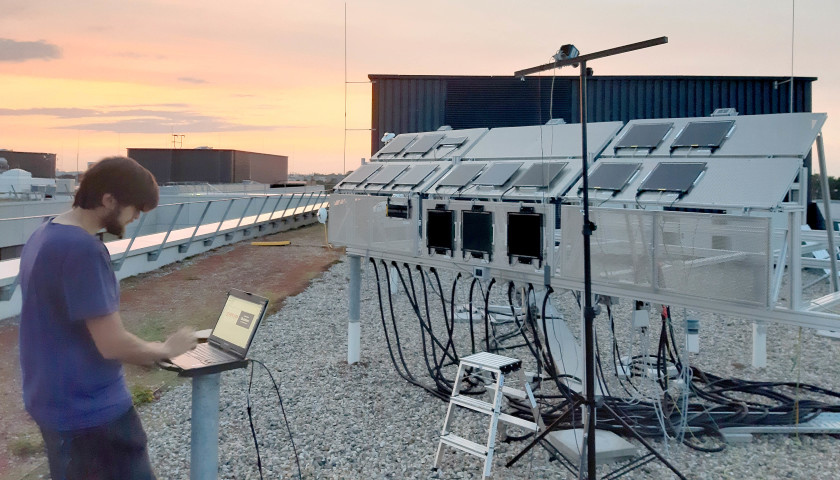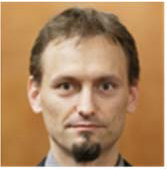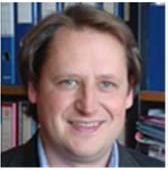Project TAPAS
Work Packages
The TAPAS project is coordinated by Prof. Dr. Steve Albrecht at HZB, and Prof. Dr. Marko Topič at LPVO-UL. It initially covers a three-year period, with an outlook on two more years.
The project itself is structured in five interconnected work packages (WPs) which are described below and serve as an indicator for the progress made. The leadership in each WP is being shared between HZB and UL. The principal investigator (PI) is the main responsible.
5 interconnected work packages (WPs)
WP 1 - Joint R&D
To help fulfill the goals of this work package, two PhD students were employed and are working on a double degree from UL and TU Berlin (this work package is strongly connected to WP3). The candidates divide their time between both institutions to ensure that knowledge is shared.
The first PhD project is about extending both the UL optoelectrical modelling (like CROWM or ASPIN3) and analytic techniques on new single and tandem solar cells, which will be developed within the project and fabricated at HZB. This means that monocrystalline silicon wafers, perovskite cells and tandem devices comprised of silicon and perovskite sub-cells will also be considered. Local characterization techniques, such as LBIC or EL, that are available at high lateral resolutions will be used to investigate the quality of the absorber materials and try to find loss mechanisms present in the devices.
Within this work package we are aiming to study the individual (sub-)cells’ electronic quality to develop new absorber materials, contacts and cell-interconnection for future tandem concepts.
The second PhD project is about correctly capturing and modelling the potential influence that MPP-tracker conditions (internal bias, charge carrier density and incident photon energy) might have on stability and lifetime of perovskite-based single-junction or tandem solar cells. A module-like system will be analyzed by simply connecting into devices series together with conditions shading, reverse bias and potential-induced degradation.
Based on these finding, we will be able to make reliable forecasts regarding outdoor energy yield in real world conditions. According to those conditions different perovskite cells/tandems can be designed.
WP 2 – Infrastructure
For R&D activities within the TAPAS project, part of the infrastructure exists already, while some part will need to be upgraded or developed.
The Laboratory of Photovoltaics and Optoelectronics, University of Ljubljana (LPVO-UL) has been developing modelling and characterization tools very successfully. SunShine (1-D) and CROWM (3-D) for example are optical modelling tools developed within LPVO-UL that are used for modelling both nano- and macro-texturing features of interfaces, which cannot be handled by commercial software packages. Among the advanced characterization tools from LPVO-UL are e.g. LBIC mapping (at λ=633 nm) and EL imaging with the possibility to measure small area solar cells and a large-area setup for PV modules, all of them with the focus on analysis of spatial inhomogeneities.
In order to further strengthen the collaboration in view of the global development towards tandem solar cells in the future, this portfolio is going to be updated in several ways. One is to develop a small area LED-based solar simulator in combination with their MPP tracking system, both specifically designed for measurements of perovskite/silicon tandem solar cells. Another big step is to build a small technology lab at LPVO that will be based on the HySPRINT innovation lab at HZB. This way, we can fabricate perovskite single-junction solar cells at both institutions, which will enable faster and broader research, and hopefully a direct and simple transfer process of our discoveries. The reproducibility, as one of the key aspect in perovskite research, can also be tested this way. Furthermore, it is necessary to upgrade and combine the existing optoelectrical software for the respective setups.
In the project, Helmholtz-Zentrum Berlin für Materialien und Energie GmbH (HZB) will be using its existing infrastructure for electro-optical analysis as well as sample preparation (in HySPRINT and PVcomB).
That means the existing indoor analytical labs for electro-optical characterization will be used as well as the new indoor MPP tracking and outdoor MPP tracking equipment, combined with a small area LED-based sun simulator that is as previously mentioned being built at LPVO-UL. The baseline solar cell fabrication process, which is part of HySPRINT and will be used for preparing perovskite single-junction cells or top cells in tandem solar cells, was recently completed. This will enable a higher throughput of devices and speed-up the optimization process.
On the HZB side, the main focus with regard to infrastructure within the project will be on further developing the setups in order to measure long-term stability of tandem devices. That includes the expansion of the current outdoor test stand and also equipping it with MPP trackers to ultimately have sufficient space for the samples we want to investigate. Having measurement data at different geographical locations (Berlin, Ljubljana) allows us to collect location dependent data and investigate additional parameters.
WP 3 – Education
According to the agreement between TU Berlin and UL, the educational focus will be primarily on the training of PhD students and research stays of post-docs or group leaders.
MSc students who work within the TAPAS project will do an internship at HZB/TUB or UL that will result in MSc theses. For the 6-month internship they will use the ERASMUS mobility program and receive help by e.g. a MSc thesis supervisor who will shape the program of the internship to the MSc thesis’ theme.
PhD students will be enrolled at both universities, into the TU Berlin and UL PhD Program. For the double-degree, TU Berlin requires their PhD students to stay in Germany for about 12 months. UL on the other hand requires double-degree students to pass at least 4 seminars during a minimum stay of 6 months.
HZB highly encourages its post-docs to gain specific expertise in modelling and characterization, which will be supported by visiting LPVO-UL. Post-docs from UL of course will have the opportunity to gain expertise in various solar cell deposition and analysis techniques by visiting HZB.
Senior scientist: The concept of young investigator group (a successful German concept) has yet to be introduced to Slovenia. However, UL is very interested and eager to learn more about this concept and wants to try to find a way among existing university regulations and legislative constraints to implement such concept with the help the European Partnering project. Based on this idea of a career direction, an equivalent tenure track will be created at UL, further strengthening this relationship.
WP 4 – Dissemination
The aim of this work package is to share project results with all people (involved with the project) as effectively as possible by using proactive communication activities.
The project webpage serves the goal in the aspect of promoting and disseminating project results to a wider audience using the web.
Students associated with the TAPAS project will help prepare promotional materials for their results and will also help to organize events.
To strengthen the existing Euroregional Photovoltaic Workshop (http://euroreg-pv.fe.uni-lj.si/) it is planned to upgrade the workshop with a Summer School on Electro-Optical Modelling and Characterization to serve as a platform for promotion of European Partnering with the purpose of disseminating the project results. It will also have the very important goal of serving as a hub for students from the Balkan region (Balkan PV hub - Cratia, Serbia, Bosnia and Herzegovina, North Macadonia, Bulgaria, Romania).
Post-docs and PhD students in the project will be encouraged to present their findings at the Slovenian Photovoltaic conference SLO-PV (every second year) and at the HySPRINT industry day (yearly), where many companies from the PV industry are exhibiting and/or have organized presentation topics. Additionally, PhD students will benefit from the HZB HyPerCells graduate school. A strong network that holds regular meetings for scientific exchange.
WP 5 - EU Consortium
Based on the results in WP 1-4 we want to begin a cooperation among partners that have PV monitoring infrastructure available for the purpose of R&D on prototype PV modules as well as on PV modules who are commercially available.
Our goal with that is to build up a library containing different system evaluation tools and other approaches related to filtering and evaluating data and forecast methods. In addition to that it is also planned to build up a second database of component failure and degradation modes with a correlation to climatic conditions.
We want to use those databases to understand and improve energy performance and the reliability of PV modules as well as generally of solar energy PV systems in Europe. This will ultimately lead to lower costs of electricity, which is produced by PV systems with a higher energy yield, and will also be appealing for investors because the ability to detect system failures or even predict them in early stages will have a huge positive impact on financial risks. Therefore, the objective of the Cost Action PEARL PV [COST Action CA16235], that the partners LPVO-UL and HZB are part of, as written in its summary and Memorandum of Understanding, is strongly implemented into this work package:
“On the long run, a big data infrastructure of different climatic sites would provide a basis for modeling of longer lifetimes, eventually beyond the guaranteed 20 or 25 years currently specified by manufacturers, and for a reduction in the perceived risk in investments in PV projects.”
However, a network containing R&D research centers that focus on reliability and performance has not been successfully created yet. For that we want to prepare an EU proposal describing such network, thus creating a database for the EU accumulating PV system performance data.






